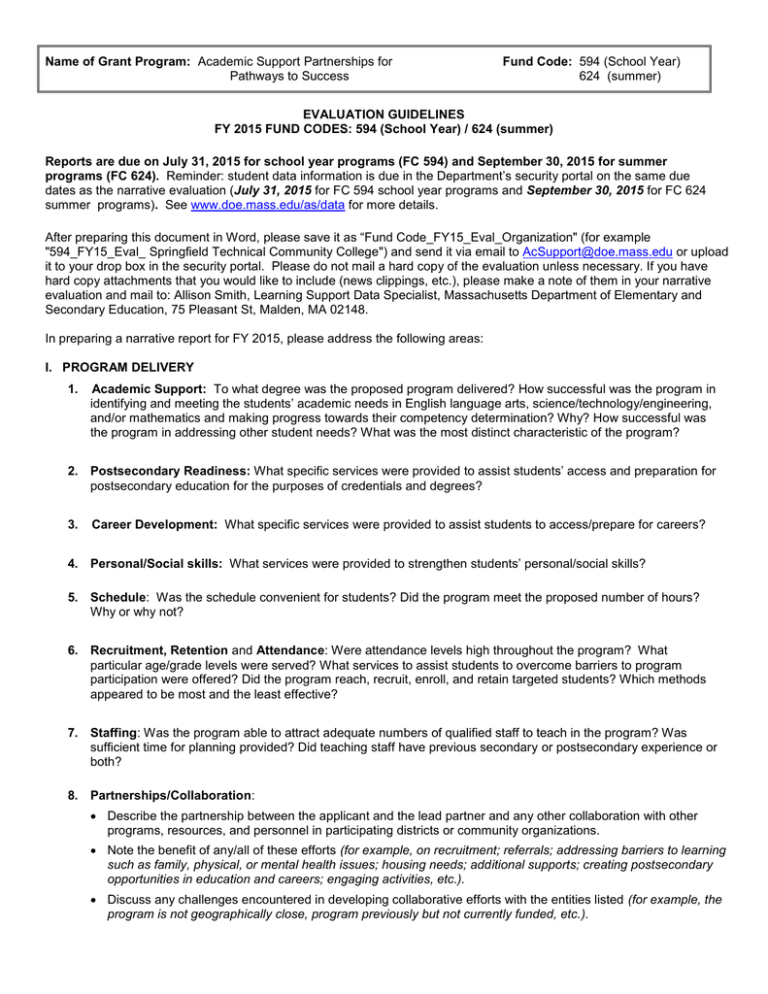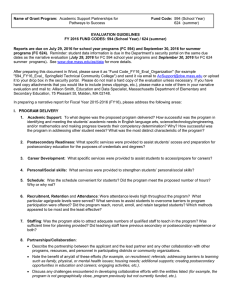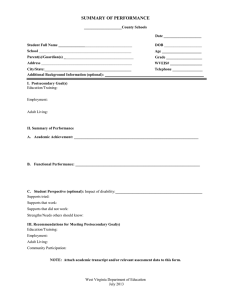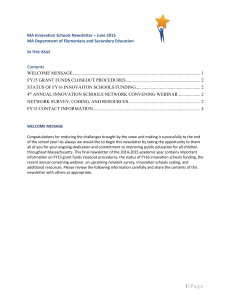fy15 594 624eval
advertisement

Name of Grant Program: Academic Support Partnerships for Pathways to Success Fund Code: 594 (School Year) 624 (summer) EVALUATION GUIDELINES FY 2015 FUND CODES: 594 (School Year) / 624 (summer) Reports are due on July 31, 2015 for school year programs (FC 594) and September 30, 2015 for summer programs (FC 624). Reminder: student data information is due in the Department’s security portal on the same due dates as the narrative evaluation (July 31, 2015 for FC 594 school year programs and September 30, 2015 for FC 624 summer programs). See www.doe.mass.edu/as/data for more details. After preparing this document in Word, please save it as “Fund Code_FY15_Eval_Organization" (for example "594_FY15_Eval_ Springfield Technical Community College") and send it via email to AcSupport@doe.mass.edu or upload it to your drop box in the security portal. Please do not mail a hard copy of the evaluation unless necessary. If you have hard copy attachments that you would like to include (news clippings, etc.), please make a note of them in your narrative evaluation and mail to: Allison Smith, Learning Support Data Specialist, Massachusetts Department of Elementary and Secondary Education, 75 Pleasant St, Malden, MA 02148. In preparing a narrative report for FY 2015, please address the following areas: I. PROGRAM DELIVERY 1. Academic Support: To what degree was the proposed program delivered? How successful was the program in identifying and meeting the students’ academic needs in English language arts, science/technology/engineering, and/or mathematics and making progress towards their competency determination? Why? How successful was the program in addressing other student needs? What was the most distinct characteristic of the program? 2. Postsecondary Readiness: What specific services were provided to assist students’ access and preparation for postsecondary education for the purposes of credentials and degrees? 3. Career Development: What specific services were provided to assist students to access/prepare for careers? 4. Personal/Social skills: What services were provided to strengthen students’ personal/social skills? 5. Schedule: Was the schedule convenient for students? Did the program meet the proposed number of hours? Why or why not? 6. Recruitment, Retention and Attendance: Were attendance levels high throughout the program? What particular age/grade levels were served? What services to assist students to overcome barriers to program participation were offered? Did the program reach, recruit, enroll, and retain targeted students? Which methods appeared to be most and the least effective? 7. Staffing: Was the program able to attract adequate numbers of qualified staff to teach in the program? Was sufficient time for planning provided? Did teaching staff have previous secondary or postsecondary experience or both? 8. Partnerships/Collaboration: Describe the partnership between the applicant and the lead partner and any other collaboration with other programs, resources, and personnel in participating districts or community organizations. Note the benefit of any/all of these efforts (for example, on recruitment; referrals; addressing barriers to learning such as family, physical, or mental health issues; housing needs; additional supports; creating postsecondary opportunities in education and careers; engaging activities, etc.). Discuss any challenges encountered in developing collaborative efforts with the entities listed (for example, the program is not geographically close, program previously but not currently funded, etc.). Name of Grant Program: Academic Support Partnerships for Pathways to Success Fund Code: 594 (School Year) 624 (summer) II. SUMMARY In the summary, please address both academic support and college/career transitional services. 1. Program Strengths 2. Program Weaknesses 3. Anecdote – Please provide one or more short anecdote(s) and/or any other contextual information that demonstrates the success of the program. 4. Feedback From Participants, Staff And Stakeholders Surveys – Indicate participant, staff and stakeholder feedback received through any surveys conducted and describe the process for collecting the information. Other – Provide letters or other testimonials from participants. III. PERFORMANCE MEASURES What progress was made in the baselines and targets that were detailed in the agreed-upon performance measures? Anticipated Outcome How will it be measured? Baseline # and/or % Target # and/or % By When? Actual or projected outcome IV. CONTINUATION For programs interested in continuation funding for FY16, please provide the following based on the information provided above: 1. Program Changes and Adaptation: What changes to programming for FY16 will be made based on the information provided above. 2. New Performance Measures Describe the program’s anticipated improvements for students that will be a result of proposed activities. Use the chart below to present performance measures that the program will track. Anticipated Outcome How will it be measured? Baseline # and/or % Target # and/or % By When?



